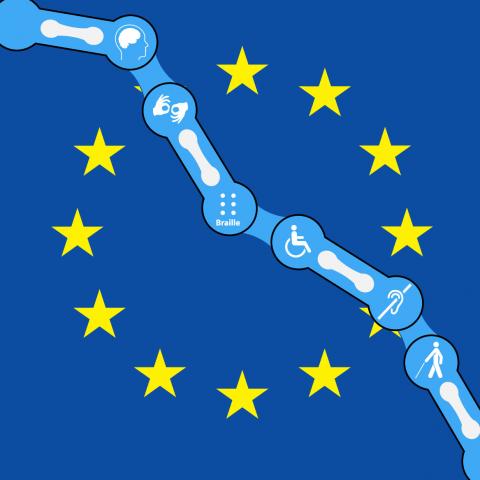EU Framework for the UN Convention on the Rights of Persons with Disabilities

The Convention is a powerful tool to help people with disabilities, local communities and governments explore ways of fulfilling the rights of persons with disabilities by developing and implementing legal, policy and practical measures.
In 2010, the European Union (EU) became a party to the CRPD by Council Decision 2010/48/EC, undertaking, within its competences, to promote, protect and ensure the full and equal enjoyment of all human rights and fundamental freedoms by all persons with disabilities, and to promote respect for their inherent dignity.
As a party to the CRPD, the EU has designated such a framework for matters of EU competence, including:
- EU legislation and policy: non-discrimination, passengers' rights, EU funding, etc.
- EU public administration: personnel selection, access to documents, etc.
To ensure that these efforts comply with the Convention’s requirements and are implemented effectively and efficiently, Article 33(2) of the UN Convention on the rights of persons with disabilities (CRPD) requires State Parties to the Convention to establish a framework to promote, protect and monitor implementation of the CRPD.
The EU Framework complements national monitoring frameworks, which are responsible for promoting, protecting and monitoring the CRPD in EU Member States.
The Framework became operational in 2013, based on a proposal by the Commission that was endorsed by the Council of the EU in 2012. In 2017, the Framework was revised by the Council of the EU to modify its composition.
Who are the members?
The EU Framework is composed of:
- European Parliament
- European Ombudsman
- EU Agency for Fundamental Rights (FRA)
- European Disability Forum (EDF)
The European Commission was a member of the EU Framework until late 2015, when it announced its intention to withdraw following the publication of the Concluding observations on the EU by the Committee on the Rights of Persons with Disabilities (CRPD Committee). Following this announcement, the European Commission no longer participates in the activities of the EU Framework.
What do members do?
According to their respective competences and mandates, members contribute collectively to the:
- promotion,
- protection, and
- monitoring
of the implementation of the CRPD by the EU.
The EU Framework also contributes actively to the review of the EU’s implementation of the CRPD by the Committee on the Rights of Persons with Disabilities (CRPD Committee). The CRPD Committee, the so-called ‘treaty body’ for the CRPD, is responsible for assessing whether parties to the Convention are meeting their obligations under the CRPD.
The first review by the CRPD Committee of the EU’s implementation of the CRPD took place in 2015; the second and third reviews took place in 2025.
How does the EU Framework work in practice?
Framework members share information and take account of each other’s activities. They agree on a work programme that can include activities implemented by several members together or by the Framework as a whole.
The Chair of the EU Framework is appointed for one year and is subject to a rotation system. The Chair promotes the principle of collegiality which is inherent to the Framework's working methods.
The EU Framework Secretariat is appointed for two years and coordinates the organisation and preparation of meetings. FRA is currently the Framework Secretariat.
- Operational provisions (roles of the Chair and Secretariat, working methods)
The EU Framework meets at least twice a year. Decisions are taken by consensus.
National monitoring frameworks
The EU Framework complements the national monitoring frameworks in EU Member States responsible for promoting, protecting and monitoring the CRPD and its implementation at national level. They can take various forms and be composed of several organisations, such as:
- national equality bodies,
- Ombudspersons,
- National Human Rights Institutions,
- monitoring committees with the participation of representatives of organisations concerned with the rights of persons with disabilities.
The EU Framework works to enhance synergies with national monitoring frameworks. For example, it meets annually with representatives of national monitoring mechanisms in EU Member States to share information and coordinate activities.
Monitoring networks
Some of the members of national monitoring frameworks cooperate at the European level:
- The Working Group on the UN Convention on the Rights of Persons with Disabilities of the European Network of National Human Rights Institutions brings together national human rights institutions which are part of national monitoring frameworks. Several EU Framework members – the European Ombudsman, the EU Agency for Fundamental Rights and the European Disability Forum – have observer status;
- Equinet, the European Network of Equality Bodies, brings together more than 40 organisations empowered to combat discrimination across a range of grounds including disability, from all EU Member States as well as from Albania, North Macedonia, Montenegro, Norway and Serbia;
- The European Network of Ombudsmen consists of over 95 offices in 36 European countries. Some of its members act as monitoring bodies for the UN Convention.